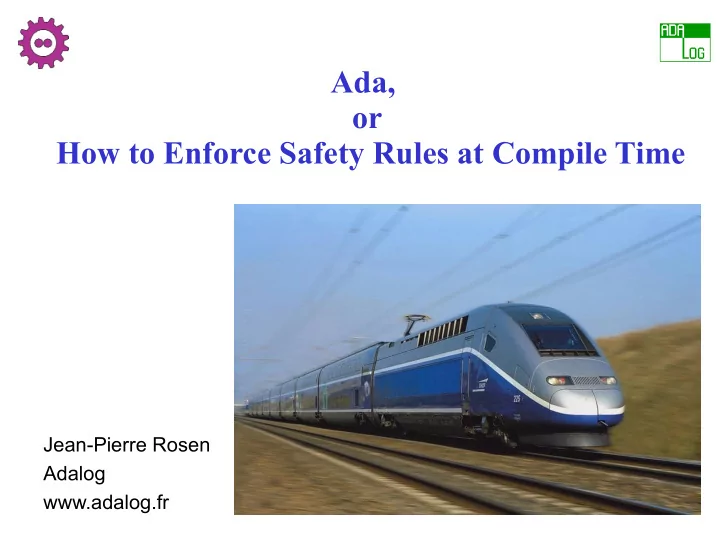

Ada, or How to Enforce Safety Rules at Compile Time Jean-Pierre Rosen Adalog www.adalog.fr
Safety Integrity Levels and Segregation ● Railway systems: EN-50128 defines 5 “integrity levels” ➢ From SIL0 (not critical) to SIL4 (highest criticality) ➢ Constraints (and costs!) increase with SIL level ● Mixed criticality systems: ➢ Same computer running various criticality applications ➢ Same application with various criticality components ● How to make sure that unsafe components do not alter safe ones? ➢ Validate all components at highest level (expensive!) ➢ Hardware protection ➢ Proofs hardware Segregation software
Segregation Requirements ● Components based architecture with only two levels: SIL0 (not certified) and SIL4 (certified) components ● Data ➢ Data can be passed from SIL0 to SIL4 Deemed unreliable, SIL4 access must go through special gateways to check ● validity ➢ No direct access of SIL4 data by SIL0 components ● Components ➢ Some components are not by themselves SIL4, but may be called by SIL0 as well as SIL4 components Classified as SIL4 ● ➢ SIL0 components shall not call other SIL4 components ➢ SIL4 components shall call SIL0 components only through special isolation components
Child Unit and Visibility ● A package can be a child of another package (the parent ) ➢ Public child package Parent.Child is ... ● ➢ Private child private package Parent.Child is … ● ● A public child can be used by outer components ➢ But it has no visible access to the parent’s private part ● A private child can be used only by its parent and siblings (subsystem rooted at the parent) ➢ But it has visibility on the parent’s private part
Structure Public Private child unit/child Safe_Components Unsafe_Components Shared_Services Data X-Memory Data Safe_1 Safe_2 Unsafe_1 Unsafe_2
Structure Public Private child unit/child Safe_Components Unsafe_Components Shared_Services Data X-Memory Data Safe_1 Safe_2 Unsafe_1 Unsafe_2
Other Checks ● Prevent users from cheating with the rules ! ➢ Requires static analysis ● Use of AdaControl ➢ Free tool provided by Adalog : www.adacontrol.fr ● Ensures : ➢ No unchecked programming Can’t be hidden in Ada ● ➢ No removal of language checks, including in SIL0 components ➢ No visible variable in package specifications
Achievements ● Criticality of a component is immediately identifiable from its full name ➢ The name defines applicable rules ➢ Cross-criticality accessors are easily identified ● The most important rules of segregation are enforced by proper usage of language features ➢ Violations don't compile! ● Simple static analysis demonstrates that there is no cheating with the rules Name another language that can achieve that...
Recommend
More recommend